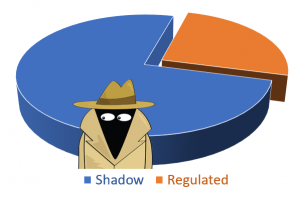
By Richard Morey
March 6, 2024

To a Bright Future
Since we’ve had unresolvable debt problems – and we’re far past the “point of no return” by now – I have tended to focus upon an analysis of the underlying weaknesses I’ve seen in the economy. Most of this short report is focused instead on explaining why I am so optimistic on our economy over the longer term.
My shorter-term concerns of course remain, and from an economic standpoint these concerns have already come to fruition. The decade that included the mortgage crisis had the exact same overall economic growth as the decade 1930-1939. Over the last ten years the economy has now averaged 2.5% a year (FRED of the St. Louis FED). Not much to brag about.
But even this modest growth was “purchased” with debt bubbles encompassing the consumer, corporate and government sectors. Consumer debt hit an all-time high last year, while government debt breaks new records every day.
Corporate debt is much harder to analyze because so much of the risky debt is in the shadow banking system. That system is now much larger than the public banking system when it comes to corporate debt. In fact, I’m not overly worried at this time about publicly-traded corporate debt. It hasn’t grown through the roof in the last decade like shadow banking assets. Plus, the credit quality of the bulk of the U.S. corporate bond market is much higher than it was preceding substantial losses in the past.
harder to analyze because so much of the risky debt is in the shadow banking system. That system is now much larger than the public banking system when it comes to corporate debt. In fact, I’m not overly worried at this time about publicly-traded corporate debt. It hasn’t grown through the roof in the last decade like shadow banking assets. Plus, the credit quality of the bulk of the U.S. corporate bond market is much higher than it was preceding substantial losses in the past.
This doesn’t, unfortunately, let all but our very largest banks off the hook from the now quickly developing commercial real estate meltdown. Just this year, numerous huge buildings have been selling at half price. Until now, almost none of the losses have appeared on the bank balance sheets. But with  high-profile buildings selling at 50% off, the banks will soon have to begin to admit their losses. Several hundred regional banks that own most of the debt on these buildings are in serious trouble.
high-profile buildings selling at 50% off, the banks will soon have to begin to admit their losses. Several hundred regional banks that own most of the debt on these buildings are in serious trouble.
The good news is that our largest, most dominant banks don’t appear to have much exposure at all to the troubled commercial real estate loans. Yes, those real estate loans are likely to bring down a disturbing number of regional banks, but at least this in itself shouldn’t affect the functioning of our consumer banking system.
Now I would like to change focus and explain why we’re optimistic about the economy longer-term. This is based on exactly two simple factors, and their relationship to the accounting identity (i.e. the mathematical “truth”) regarding economic growth or GDP:
- We have a hard-working, highly productive workforce. Even our younger workers may very well, I suspect, turn out to have unusual value as AI becomes ubiquitous. They’ll probably be the ones using it for a million actual productivity gains. In other words, I believe our younger generations are likely to turn out to be the most productive workforce we’ve had in this country since around the 1950s. That’s what it’s looking like AI is going to do from a productivity standpoint. (Of course, this assumes it isn’t used to destroy ourselves first!)
GDP = Total Number of Hours Worked x Productivity Growth. That one equation tells me AI will – once fully developed and implemented – lead to an economic boom for some period of years. It should lead to a productivity boom that also requires a huge amount of hours worked to create and implement.
Number of Hours Worked x Productivity Growth. That one equation tells me AI will – once fully developed and implemented – lead to an economic boom for some period of years. It should lead to a productivity boom that also requires a huge amount of hours worked to create and implement. - We also have the most entrepreneurial group of workers in the world. This second point shouldn’t be underestimated, as this entrepreneurial spirit has been the fuel for our nation’s growth – I would say since inception.
Optimistic on the Stock Market?
My only real problem with today’s investment environment is the price. Personally, I wouldn’t mind owning a representative  group of our most successful companies for the remainder of my life. Rather, I wouldn’t mind owning that representative group at around 60% or so below today’s prices. Not only that, but I want to own the stock of companies that prove they can weather any difficult time that may come along. Then I’ll buy the winners for the long-term.
group of our most successful companies for the remainder of my life. Rather, I wouldn’t mind owning that representative group at around 60% or so below today’s prices. Not only that, but I want to own the stock of companies that prove they can weather any difficult time that may come along. Then I’ll buy the winners for the long-term.
From energy to computing to biotechnology, we have business owners and entrepreneurs ready to profit when their competition is no longer propped up by a near endless supply of cheap debt.
If a person owns stock today, I wouldn’t sell it unless I was overweight such that I couldn’t keep it – no matter what – for the next decade or longer. Of course, if a person doesn’t own much if any stock now I certainly wouldn’t buy it. I’m quite optimistic over the next 10-15 years, but expect the early part of a major market downturn will be quite difficult for most.
Conclusion
Driving home today, it hit me that my generation – and those born after – have never really had to face anything very hard. Personally, I’m pretty sure we’re up to the task. It can only be good for an economy to resolve bad debt, and the playing field can only get more level from here.
playing field can only get more level from here.
But we’ve still got the workers and productivity on our side, and the willingness to work and better ourselves. As a result, Warren Buffett should turn out to be correct once again when he says our better days still lie ahead. This is highly likely to be true in stocks as well – at a sane price.
For now, our only concerns are safety and income– along with being poised to benefit from extreme volatility should it occur in any of the markets around the world.
Speaking of Income:
Our relationship with Nationwide Insurance Company is bearing fruit in the form of the highest guaranteed income we’ve seen in a very long time. We are encouraging clients that have a need to secure more pension -like monthly income to get a quote. (we can provide from our office)
